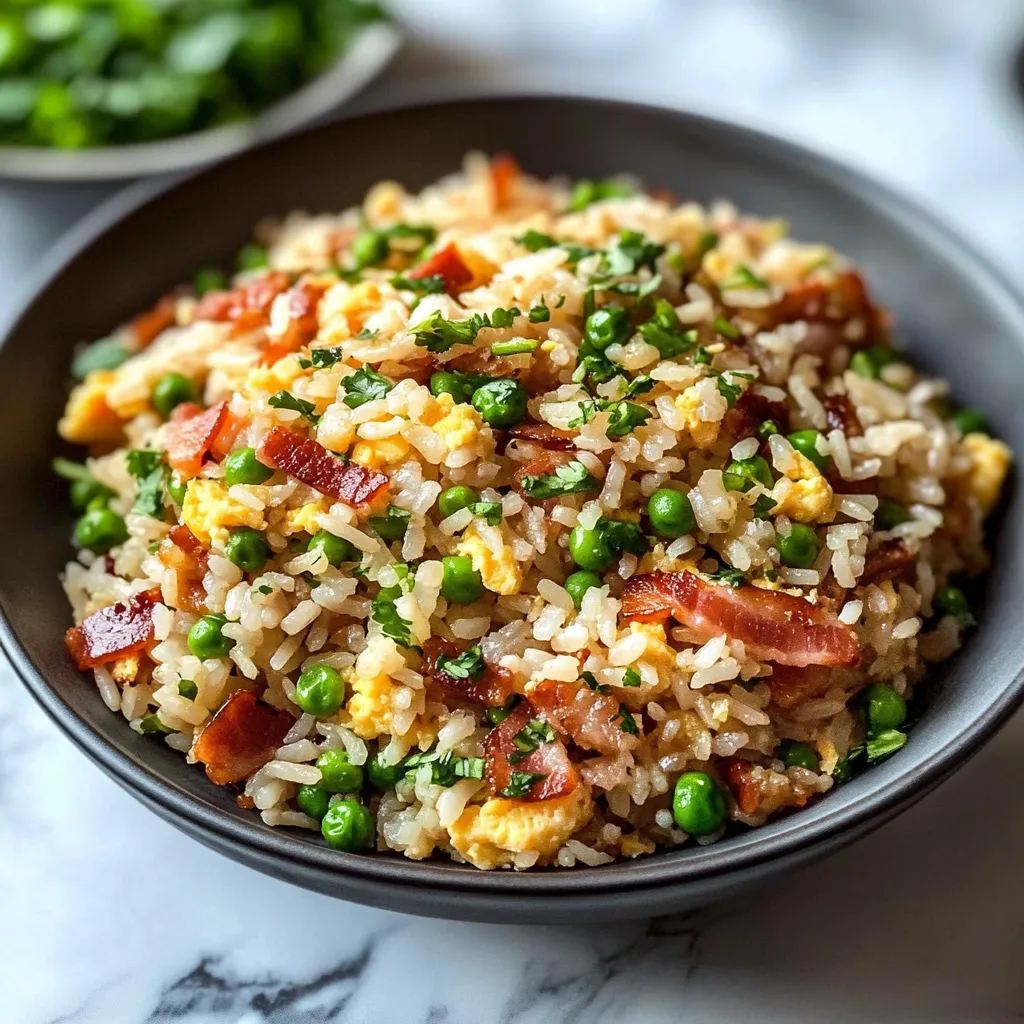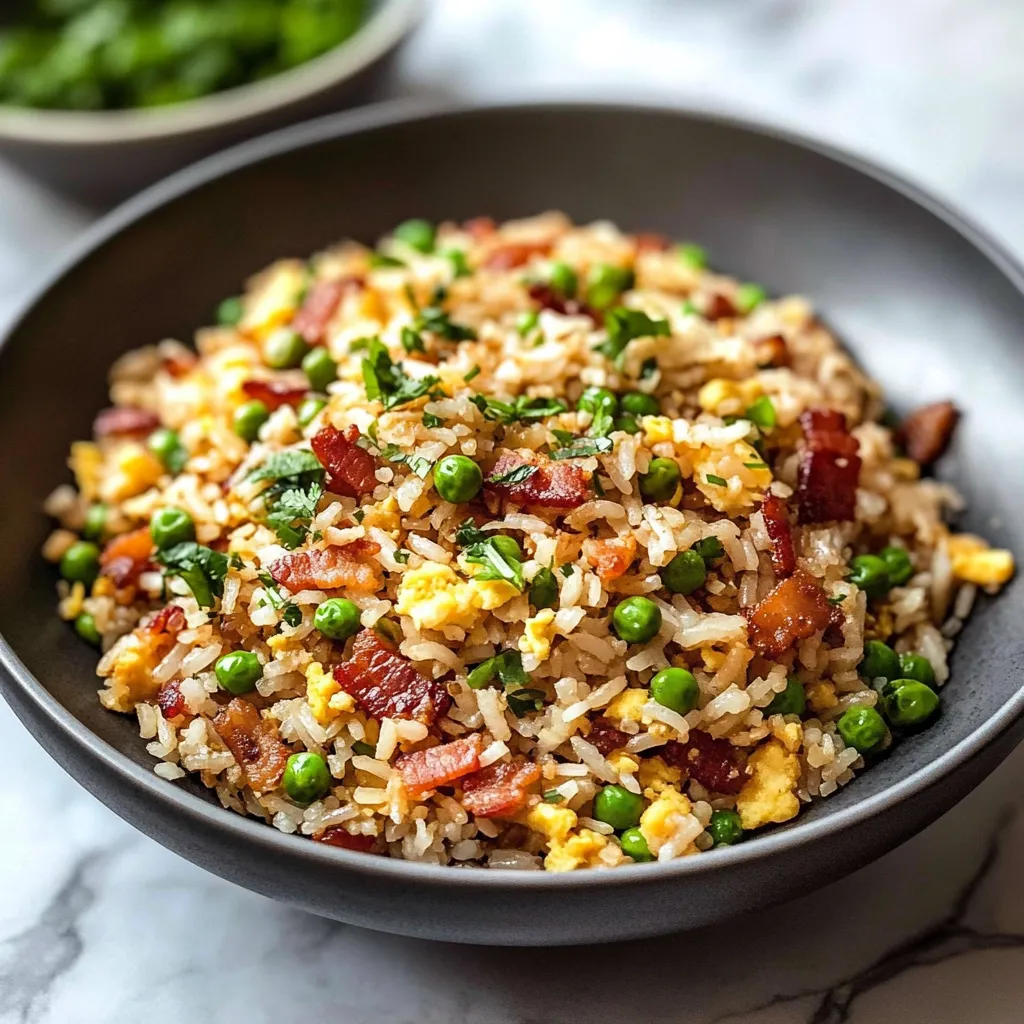 Pin it
Pin it
Bacon fried rice transforms humble leftovers into a magnificent one-pan meal by combining crispy, smoky bacon with seasoned rice, tender vegetables, and fluffy eggs that come together in perfect harmony. This versatile dish delivers the rich, umami-packed flavors of traditional fried rice enhanced by bacon's irresistible savoriness, creating a deeply satisfying meal in just minutes. I discovered this delicious adaptation during a busy weeknight when I had day-old rice and breakfast bacon that needed using—the resulting dish has since become our family's most requested weeknight dinner.
Last month when unexpected dinner guests arrived, I quickly prepared this dish with ingredients already in my refrigerator. What surprised me most was watching my notoriously picky nephew request seconds and then thirds without picking out a single vegetable. The magical combination of familiar bacon with the comfort of rice seems to transform even selective eaters into enthusiastic diners.
Essential Elements
- Thick-cut bacon: Provides both the protein component and the cooking fat; choose good quality with a nice balance of meat and fat
- Day-old rice: Creates the perfect texture; freshly cooked rice contains too much moisture and becomes mushy
- Farm-fresh eggs: Contribute richness and protein; room temperature eggs integrate more smoothly
- Aromatic vegetables: Onions, garlic, and green onions build the flavor foundation; slice uniformly for even cooking
- Frozen peas and carrots: Add color and nutrition without requiring additional prep; thaw slightly before cooking
- Soy sauce: Provides essential salt and umami; use low-sodium to better control the final seasoning
- Sesame oil: Just a small amount delivers tremendous depth; add at the end to preserve its aromatic qualities
- Oyster sauce: Creates complex flavor that would otherwise require multiple ingredients; vegetarian versions work well too
I learned an important lesson about rice preparation with my first attempt at this dish. Using freshly cooked, still-warm rice created a gummy, disappointing texture that stuck to the pan. Now I always plan ahead, cooking extra rice specifically to use in this recipe after it's thoroughly chilled. The difference in texture is remarkable—each grain remains distinct while absorbing all those wonderful flavors.
Wok Wisdom
- Begin With Bacon:
- Start by adding chopped bacon to a cold wok or large skillet, then gradually increase to medium heat. This slow rendering approach allows the fat to release evenly without burning, creating perfectly crispy bacon bits and flavorful oil for cooking the remaining ingredients. Once the bacon reaches your desired crispness, remove it with a slotted spoon, leaving the rendered fat behind as liquid gold for your vegetable base.
- Build Flavor Foundations:
- In the bacon fat, sauté diced onions until they become translucent and their edges begin to caramelize slightly, about 3-5 minutes. This caramelization creates essential depth that forms the backbone of your dish. Add minced garlic and cook just until fragrant, about 30 seconds—any longer risks burning and introducing bitterness. Incorporate thawed frozen peas and carrots, cooking until just tender-crisp, maintaining their vibrant color and texture.
- Master The Rice:
- Add chilled rice to the vegetable mixture, breaking up any clumps with your spatula. Toss frequently to coat each grain with bacon fat and allow the rice to heat through completely, about 2-3 minutes. The key here is maintaining enough heat to slightly toast the rice without burning it, creating that distinctive fried rice texture where each grain remains separate and slightly chewy.
- Create Egg Ribbons:
- Push all ingredients to one side of the pan, creating an empty space. Pour beaten eggs into this clearing and allow them to set slightly before gently scrambling. This method creates soft, delicate curds rather than coating the rice with egg. Once the eggs are just barely set but still glossy, fold them into the rice mixture, distributing them evenly throughout.
- Unite The Flavors:
- Return the crispy bacon to the pan and increase heat to high. Add soy sauce, oyster sauce, and sesame oil, tossing continuously to coat all ingredients evenly. The high heat helps the sauces caramelize slightly on the rice, creating complex flavor in every bite. Finish with a generous sprinkle of sliced green onions, which add fresh color and a bright flavor contrast to the rich, savory elements.
 Pin it
Pin it
During a family vacation in a poorly equipped rental home, I attempted this dish in a thin aluminum pan. The uneven heating created patches of burning alongside underdone vegetables. I've since learned that proper equipment—particularly a heavy-bottomed pan that retains heat well—is essential for achieving that restaurant-quality result. When traveling, I now pack my seasoned carbon steel wok, considering it as important as my chef's knife for consistent cooking results.
Serving Style
This versatile dish works beautifully as either a main course or side dish depending on your needs. For a complete meal, serve it in deep bowls garnished with additional sliced green onions, sesame seeds, and a drizzle of chili oil for those who enjoy heat. When offering it as a side dish alongside Asian-inspired entrées like teriyaki chicken or beef and broccoli, present it family-style on a large platter that showcases the colorful ingredients. For lunch portions, pack it in insulated containers—this dish tastes delicious even at room temperature, making it perfect for work or school lunches.
Flavor Variations
While the classic version shines brilliantly, this adaptable recipe welcomes creative modifications. Create a spicy version by adding sriracha or sambal oelek when incorporating the sauces. For a Hawaiian twist, include diced pineapple along with the vegetables for sweet-savory contrast. Enhance the protein content by adding diced leftover chicken, shrimp, or tofu with the rice. For a vegetarian version, substitute mushroom bacon and use extra sesame oil to maintain that smoky richness. During spring, incorporate seasonal vegetables like asparagus tips or fresh peas instead of frozen for brightness and texture.
Storage Strategy
This dish maintains its quality remarkably well when properly stored, making it perfect for meal preparation. Store cooled leftovers in airtight containers in the refrigerator for up to three days. For reheating, a quick stir-fry in a hot skillet with a splash of water restores the perfect texture better than microwave reheating, which can make the rice too soft. For busy weekday planning, prepare double batches of rice on the weekend, storing the portion for fried rice in the refrigerator until needed. The flavors actually improve slightly with an overnight rest as they meld together more completely.
I've been perfecting this bacon fried rice for nearly seven years, making subtle adjustments with each preparation. What began as a simple leftover solution has evolved into one of my signature dishes—the one friends and family specifically request. Last Lunar New Year, my Chinese-American neighbor paid me the ultimate compliment by asking for my recipe, saying it reminded her of her grandmother's cooking but with a delicious twist. The beauty of this dish lies in its ability to transform humble ingredients into something truly crave-worthy while remaining accessible to cooks of all skill levels.
 Pin it
Pin it
Frequently Asked Questions
- → What ingredients do I need?
- You need bacon, onion, garlic, frozen peas and carrots, cooked rice, eggs, soy sauce, oyster sauce, sesame oil, salt, pepper, and green onions.
- → How long does it take to prepare?
- Prep time is 10 minutes, and total time is 30 minutes.
- → Can I use fresh vegetables instead of frozen?
- Yes, you can use fresh peas and carrots, but you may need to adjust the cooking time.
- → Is it suitable for gluten-free diets?
- Yes, this recipe is gluten-free.
- → How should I store leftovers?
- Store leftovers in an airtight container in the refrigerator for up to 3 days.
